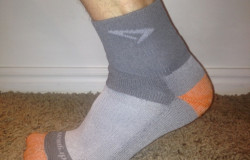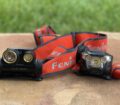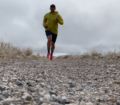In follow-up to the preview posted a couple of weeks ago, we now present the full review for your consideration. As a preface to reviewing each brand it is important to understand the process that was followed during this review process.
Companies didn’t just send a single pair of socks to one of our testers and have them go for a run and then we did a review. Each and every one of these companies stepped up and provided multiple pairs of each model to be tested, at which time we shipped a pair to each of our testers. Then, over the next five weeks, our testers ran in these socks almost exclusively. Conditions varied from dry trails, mud, deep snow, to slush and rain. The socks were dirtied, washed, and put through as much of a life cycle as possible without delaying the review any longer. Now, with the review period over, we present our results and leave it to you to decide which sock best suits your needs.
Balega Moh-Rino Approach
$16.50
“Balega” is a ZULU word, meaning “to move with speed”. Socks are made in South Africa, using yarns produced in the US. Historically a run specialty sock, Balega has refocused to include the full spectrum of ‘outdoor specialty’ and now produces socks for nearly every outdoor activity. We tested their Adventure Approach sock, meant for trail running and hiking. It is a loose knit, vented sock made of Moh-Rino (combo of wool and mohair), with arch support bands to keep the sock in place. This makes it not only a more comfortable sock, but also more stable from its trail predecessors. Feedback from reviewers are as follows:
Pro:
“Super Comfortable. Loved how soft the socks felt when on my feet. Wicked great.”
“Natural fibers. Good breath-ability. No chafing, couldn’t feel any seams. No bunching. Did not shrink with washing and drying. A good mid-weight natural fiber sock.”
Con:
“The looseness of the weave allows my foot to slide around in my shoe.”
Drymax Trail Runner
$15.99
Drymax claims to produce the driest socks on the market and they use science and user test videos to prove it. They have been receiving awards for dryness, blister protection, and comfort since 2007 and lead the market in durability. We tested the Trail Running sock, specifically designed to keep dirt from getting in and migrate moisture from the inside to the outside of the sock via two layers knit together. This was a favorite by several on the team and their comments reflect that.
Pro:
“I was shocked at how much I loved these socks. I found myself wearing them all the time – not just running. I would even wear a pair to work and then use the same socks on my run that night.”
“Sock has amazing wicking. Is very breathable. Does not fray. Never makes my feet hot.”
Con:
“It almost made my feet too dry, if that’s possible. Also the seam connection point over my little toe rubbed after 10 miles or so.”
Icebreaker Hike+ Lite Mini
$19.99
About their own products, Icebreaker put it best. “Merino wool was born not in a lab, but in the mountains of New Zealand. The Icebreaker fiber factory works 24 hours a day, on the back of a sheep”. These guys know wool and they produce nothing but Merino wool based products. Their socks have a natural, soft feel, with plenty of protection under foot. We tested the Hike+ Lite and it didn’t disappoint. Different from some of the other brands, Icebreaker uses an anatomical sock design, which means the socks are left and right foot oriented, minimizing the wear spots and reducing pressure on the sensitive areas of the foot.
Pro:
“I wore it for 70 miles of a 100 mile race before even considering changing out of it. Absolutely, the best sock I’ve ever put on my foot.”
“I liked the fit, especially the higher ankle cut. I liked the thickness of this sock and it worked well in wet/cold conditions over long miles.
Con:
“I prefer a thicker sock” (this was the only critique of the sock whatsoever)
CEP Running Compression
$59.95
CEP is a tough brand to throw into a mass review because it is unlike any other socks made on the market. They use medical grade compression which allows for increased blood flow and reduces muscle bounce which is known to cause cramping. The most challenging thing about wearing CEP is getting the sizing right. Too tight and it is uncomfortable; too loose and they will slide down. Therefore, before purchasing a pair, do the proper research, otherwise you may find the socks don’t fit right. But get it right and they might be your new favorite sock.
Pro:
“Used this sock both skiing and during a 25 mile run where I post holed to the knee. Protected my legs without getting too hot. Compression was good. Not difficult to get the socks off.”
“Very comfortable, fantastic for winter weather running – keeps the ankles protected and adds a layer of warmth. These guys have got compression dialed in.”
Con:
“Make sure and size appropriately – too tight and they can cause issues, too loose and they’ll ‘quit’ on you.”
Smartwool PHD Run Ultra Micro
$15.95
For over 17 years Smartwool has been producing the latest products and designs in Moreno wool products. Self-professed ‘wool geeks’ they understand what it means to make a sock for true mountain adventurers. They are conservation and preservation advocates and strive to uphold the greatest values and integrity in the business. If you find you don’t like their socks or have a problem with a product, just call them and you’ll understand what we’re talking about.
Pro:
“Thickness is important to me so I enjoy these SmartWool socks. They handle friction well and don’t seem to overheat.”
“Light, natural fibers, make the sock comfortable and able to wear for a long time.”
Con:
“Not enough cushion, not enough ankle coverage. Too easy for debris to get in through the fabric.”
Feetures Elite Cushion Low Cut
$14.99
Hugh Gaither is the founder of Feetures. After working in the technical sock industry for 25+ years he decided that there was a better, more natural way to produce socks that would perform better for the user. Their anatomical sock design reduces rubbing in the wrong places and allows for the Power Arch technology to support the midfoot in the right place on each foot. This light cushioned sock is very light and breathable and will keep your feet dry, even after hours of running.
Pro:
“Used these as my treadmill sock, no hotspots or discomfort, lightweight with a low profile. I like the form fitting R/L feel.”
“Natural fiber. “No show” anklet height.”
Con:
“Even though it was a thin sock it was very hot even when it was cold out. Also, allowed my foot to slide inside the shoe.”
Socks are some of the most intimate pieces of running gear we can own and once we find a brand we like we tend to remain very loyal. All runners are unique; they have different feet, body types, and running styles. Therefore, they have different needs, likes and dislikes. We can’t review one sock and say it is perfect for everyone because that simply isn’t true. What we can say is there are some amazing options to choose from to fit your specific needs and keep your feet happy!
Let’s hear it!
Have you worn any of the socks reviewed? What is your sock of choice?























all great sox no doubt. I’ve found the Wright Sock double layer (now the ‘escape’) to be the best sock value/bang for buck.
Great review. I wish the Injinji toe socks would have been included. I’ve never tried them, but heard good things. I love Drymax, although I prefer the lite trail runner to the regular version in the review. No blisters in a year and half of racing and training.
I wear Injinji merino wools in the winter and tech socks in the summer. My toes need the separation to avoid blister. They work well.
Thanks for your comments. We approached Injinji to be a part of the review. While they were very excited for us to review their products, they didn’t feel as though their socks fit into the same mold as the other brands. They asked if we do a full, brand specific review for them at a later date. Of course, we happily agreed. Worry not, we will be reviewing Injinji in the next few months and will have a full review of several models for you to choose from.
We will likely be doing a follow up mass review of a few other brands, as well. Fox River, Darn Tough, and Fits have all expressed interest and we’d love to accommodate them.
Have worn the Feetures you reviewed & others in their line – they’re my primary sock, love ’em. Be interested to try Drymax after your review but low cut style as elastic cuff on ankle is uncomfortable for me. Thanks for reviewing these, look forward to future reviews.
The surprise of the group for me was the CEP ankle cut. I am not a fan of thin socks (love my Darn Tough and Drymax year round) but was amazed at the compression on my feet. Not too much to be annoying.
The best toe seams from this group is the Feetures and Balega although I agree with rest of the testers on the sliding feel. The Balega was my go-to marathon sock before moving over to dirt and longer distances.
[…] we conducted our Great Sock Debate this spring, several people asked about Injinji socks being represented. This Summer and into early […]
[…] Observe: I wore these socks as half of a bigger sock evaluation on TrailAndUltraRunner.com as properly. You possibly can learn Craig Lloyds sock evaluate HERE. […]
It is important to have comfortable socks